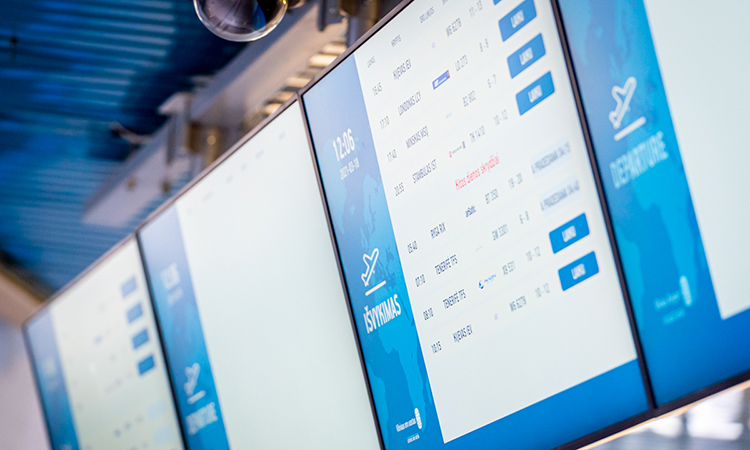New airport management system installed by Lithuanian Airports
- Like
- Digg
- Del
- Tumblr
- VKontakte
- Buffer
- Love This
- Odnoklassniki
- Meneame
- Blogger
- Amazon
- Yahoo Mail
- Gmail
- AOL
- Newsvine
- HackerNews
- Evernote
- MySpace
- Mail.ru
- Viadeo
- Line
- Comments
- Yummly
- SMS
- Viber
- Telegram
- Subscribe
- Skype
- Facebook Messenger
- Kakao
- LiveJournal
- Yammer
- Edgar
- Fintel
- Mix
- Instapaper
- Copy Link
Posted: 30 March 2021 | International Airport Review | No comments yet
In addition to a new airport management system, new Information Display Systems have also been installed by Lithuanian Airports at Vilnius, Kaunas and Palanga Airports.


Credit: Lithuanian Airports
Lithuanian Airports has announced that it has completed the installation of a new airport management system designed to enhance the passenger experience, increase operational efficiency and modernise airport operations management.
The system’s most visible element comes in the form of hundreds of flight information displays located at its airports. Whether passengers are looking for their check-in counter, boarding gate, or baggage belt – the information displayed arrives via this system.
Installed at Vilnius International Airport (VNO), Kaunas International Airport (KUN) and Palanga Airport (PLQ), the new system will increase operational efficiency by automatically processing flight updates received from standard aviation feeds. Until now, the three airports used three different operations management systems, and maintaining them was both challenging and time-consuming.
The new system allows airport operators to make timely decisions and automatically allocate airport resources like check-in desks, boarding gates and baggage claim belts. It enables a more planned, fluid and automated approach to operations, freeing up airport teams to better handle any exceptions which require their personal attention.
Additionally, Information Display Systems were also installed, meaning that flight information will be displayed on screens throughout the airport terminals. Passengers who have travelled through the country’s airports in the past weeks could benefit from the vibrant new designs used for displaying real-time flight information.
The display designs ensure that passengers can stay informed about the most important flight information and that they are informed at the right time during their journey. For departing passengers, it includes their boarding gate, departure time and information about possible delays or cancellations. For arriving passengers, information such as their baggage claim number and transfer information are provided.
Crucially, flight information will not only be displayed to passengers, but will be also shared with internal airport stakeholders. The system will enable the sharing of relevant data with the Lithuanian Police, ground handling agencies, Oro Navigacija (Lithuania’s Air Traffic Control Agency) and others.
According to Dainius Čiuplys, Head of Operations and Infrastructure at Lithuanian Airports, being able to conveniently and accurately inform passengers is of key importance for any modern airport. The installation of the new system will do just that – improve the passenger experience, help to regulate traffic flows and increase operational efficiency.
According to Čiuplys, the purpose of having the above-mentioned information display system is not only to keep passengers informed, but it is also an important part – a symbol – of the complex new system that now orchestrates the airport operations.
“For us, interconnecting various systems under one roof, digitalising processes and increasing operational effectiveness is of key importance. We operate more than 200 information screens at our three airports, all of which must be aligned by one common system. The system must ensure that the screens show relevant, correct information at the right locations at the airport, in real-time. We are confident that this new state-of-the-art system will help to administer all airport operations with greater efficiency and accuracy,” said Čiuplys.
Related topics
Airside operations, Information technology (IT), New technologies, Passenger experience and seamless travel, Terminal operations
Related airports
Kaunas International Airport (KUN), Palanga Airport (PLQ), Vilnius International Airport (VNO)


















